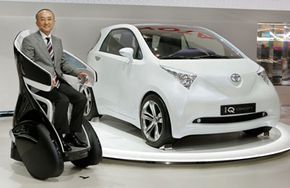As urban roads and highways become increasingly congested with traffic, one of the latest trends in automaking is the extreme downsizing of the car. The Smart Car has done very well in Europe with its ultrasmall size, modern design and great gas mileage, while the MINI Cooper and other MINI models have reemerged to immense popularity.
Advertisement
These vehicles have proven to be a boon for people looking to save on gas money and skip out on parallel parking, but there's one obvious aspect that drivers are forced to sacrifice with an ultracompact car -- the availability of space. Some might be able to get by fine in a tiny car, but travelers or larger families might have trouble carrying bigger loads with just two seats and very little trunk space.
Toyota is attempting to address this dilemma with its own take on the minicar, a four-seat passenger vehicle called the iQ Car. At just under 10 feet long and about 5-and-a-half feet wide, the iQ is an example of innovative design and technology -- everything from the seating arrangements to the miniaturized front console controls is taken into account. Although it's slightly bigger than Daimler-Chysler's Smart Car, it's still much smaller than the average 14- or 15- foot-long compact car. The iQ is also in clear competition with the Smart Car, as both names are obvious references to resourcefulness.
Toyota expects the iQ will be ready for production in late 2008, but the company plans to make the car available to European drivers only -- demand for smaller vehicles in Europe is still high, and the quirky designs of minicars are fashionable. Recent SUV sales in the United States have been declining due to higher gas prices, though, and environmentalists frown upon big gas-guzzlers like the Hummer. The Smart Car also goes on sale in the United States in early 2008, so good minicar sales might give Toyota a reason to change its mind.
To find out more about the iQ's specifications, read the next page.
Advertisement


